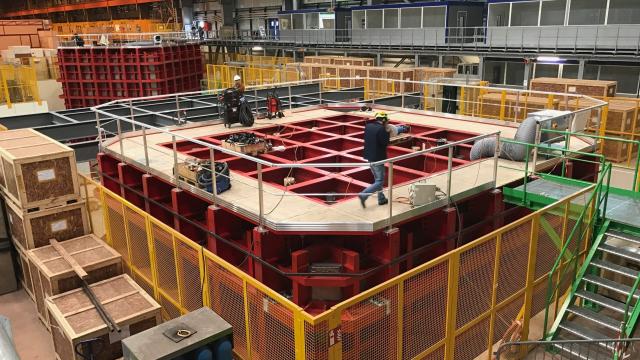Particle physics is rarely a cheap-and-easy endeavour. Just think about the Large Hadron Collider, buried deep beneath the Swiss-French border — it cost over $16 billion to find the Higgs Boson. Well, today at 6:20AM AEST, America is breaking ground on another enormous particle physics experiment.
DUNE prototypes at CERN (Image: Ryan F. Mandelbaum)
DUNE, or the Deep Underground Neutrino Experiment, is meant to study the properties of neutrinos, light (but not massless) particles that are both super common and super hard to detect. The experiment consists of two parts, which will shoot the particles 1304km from Fermilab in Illinois to the Sanford Underground Research Facility in South Dakota. It isn’t the first American neutrino experiment — there are labs deep underground in a Minnesota and South Dakotan mines (adjacent to where this experiment will be). But it will be the largest liquid argon detector ever built.
Construction is only beginning on the experiment, but its outcome will be truly massive: Four containers holding a combined 68,000 tonnes of liquid argon cooled to -184C, 1475m underground. Neutrinos interact incredibly weakly (they don’t interact with the Earth or your body, for example) and require these sensitive detectors to spot. Essentially, neutrinos from the source in Illinois will hit the liquid argon, knocking off electrons that drift into sensors on the container’s edges thanks to the presence of an electric field — the detectors register these electrons as a signal. But that sensitivity means the researchers might also pick up false hits from other particles coming from space, which is why the detectors need to be so deeply buried.
And 68,000 tonne containers are really huge. While at CERN this past April, researcher Stefania Bordoni showed me the DUNE prototypes, each of which will contain only 770 metric tonnes of argon. At 8m tall, each cube, checkered with a red metal beams lattice, looked like a shipping crate for a T. rex.
There are a few goals of the experiment, but a major one is to better understand a strange effect called neutrino oscillation. Neutrinos come in three flavours with different masses: The lightest electron neutrino, the muon neutrino, and the heaviest tau neutrino. But neutrinos can also flip between these states in a process called neutrino oscillation. Experimental discovery of this effect won two experiments the 2015 Nobel Prize for Physics.
Understanding neutrino oscillations could help us elucidate the very nature of the universe. Since neutrinos have mass, that means they’re yet another factor that scientists need to take into account when trying to explain why things look and act the way that they do. But the experiment has other purposes too, like trying to see whether protons, one of the two elementary particles that make up the atom’s nucleus, decay into other, smaller subatomic particles. No one’s ever observed such an effect… but it might happen.
Anyway, if you’re interested, even US Secretary of Energy Rick Perry is tweeting about it, so it might as well be worth tuning in.
Again, that live feed begins at 6:20AM AEST.
